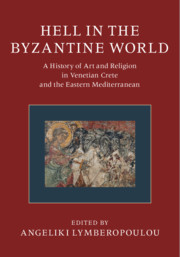 Hell in the Byzantine World
Hell in the Byzantine World Western Resonances in Cretan Wall Painting
from Part I - Crete
Published online by Cambridge University Press: 02 October 2021
Rembrandt Duits focuses on the Western aspect of Italo-Byzantine cultural and artistic interaction and thus expands the geographical setting of the Cretan representations of Hell. His chapter presents a new perspective on the origins of certain elements in the Cretan images of Hell, which he points out have parallels in Western – particularly Italian - art. He draws on a representative sample of 25 per cent of all the Cretan wall paintings showing Hell that appear to deviate from pre-established Byzantine traditions. The geographical dispersion and chronological range of the sample mean that this iconographic divergence cannot be explained as the impact of a single Cretan master or a local ‘school’. Duits draws our attention to iconographic elements that suggest an interaction of Cretan and Italian artists, such as devils pulling souls by ropes or chains, frontally rendered processions of sinners, the double-headed Dragon of the Depths, the structure of Hell, and inscriptions that identify certain sinners. He argues that while there are no clear formal derivations of Western art in Cretan Hell scenes, there is nonetheless a strong suggestion that Cretan painters were aware of certain trends in the Italian rendition of Hell.
To save this book to your Kindle, first ensure no-reply@cambridge.org is added to your Approved Personal Document E-mail List under your Personal Document Settings on the Manage Your Content and Devices page of your Amazon account. Then enter the ‘name’ part of your Kindle email address below. Find out more about saving to your Kindle.
Note you can select to save to either the @free.kindle.com or @kindle.com variations. ‘@free.kindle.com’ emails are free but can only be saved to your device when it is connected to wi-fi. ‘@kindle.com’ emails can be delivered even when you are not connected to wi-fi, but note that service fees apply.
Find out more about the Kindle Personal Document Service.
To save content items to your account, please confirm that you agree to abide by our usage policies. If this is the first time you use this feature, you will be asked to authorise Cambridge Core to connect with your account. Find out more about saving content to Dropbox.
To save content items to your account, please confirm that you agree to abide by our usage policies. If this is the first time you use this feature, you will be asked to authorise Cambridge Core to connect with your account. Find out more about saving content to Google Drive.